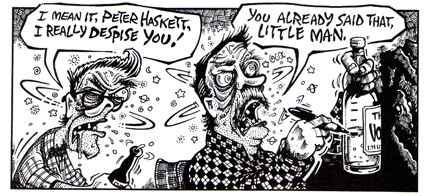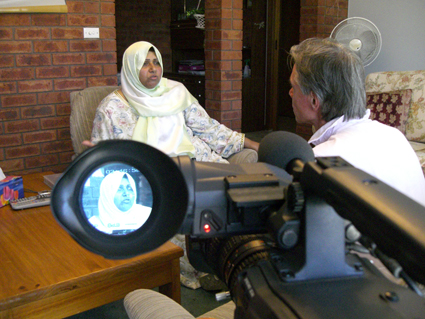small stories, big pictures, bigger reach
kath dooley: australian international documentary conference

Shut Up Little Man! An Audio Misadventure, director Matthew Bate
“FILMS DON’T CHANGE THE WORLD. PEOPLE WHO SEE THE FILMS CHANGE THE WORLD.” THIS IS THE MOTTO OF GIL SCRINE’S CINEMA VENTURES, A DOCUMENTARY DISTRIBUTION MODEL, PRESENTED AT ADELAIDE’S HILTON HOTEL AS PART OF THE 2011 AUSTRALIAN INTERNATIONAL DOCUMENTARY CONFERENCE. ALONGSIDE THE HOST OF INTERNATIONAL AND NATIONAL SPEAKERS WHO PRESENTED KEYNOTE ADDRESSES, MASTER CLASSES AND PANEL DISCUSSIONS, SCRINE WAS NOT ALONE IN STRESSING THE NEED TO RE-EVALUATE ESTABLISHED MODELS OF DOCUMENTARY FUNDING AND DISTRIBUTION IN ORDER TO EMBRACE NEW METHODS OF CONNECTING WITH AN AUDIENCE.
Over four days, conference delegates were presented with case studies of recent TV and web documentary success stories and conversations on documentary craft, as well as alternative strategies for funding and development. Running alongside the BigPond Adelaide Film Festival, where for the second time, the F4 (First Factual Film Festival) was able to showcase the work of emerging documentary makers, the 2011 conference marked the launch of P2P: CO-CREATE, a networking initiative designed to connect Australian factual content creators with international partners. With the swag of national and international commissioning editors, acquisition managers and executive producers signalling what AIDC Executive Director Joost den Hartog describes as “a new found confidence” in the TV sector, one can only hope that many a deal was struck.
In a session exploring global trends in factual television programming, Stephen Harris of American A&E Television Network spoke of the need for programs to feature big characters, high stakes and unique access—traits undoubtedly present in Channel 4’s 2011 breakout hit, Big Fat Gypsy Weddings. With 8.7 million UK viewers tuning in for the second of four episodes, this program’s success suggests that audiences want to connect with characters living in unusual or unfamiliar worlds. This premise has been explored locally (albeit on a smaller scale) through a community-made webisode project, Big Stories, Small Towns, also presented at AIDC. Giving voice to local groups in three South Australian towns, this innovative project offers its audience insight, for example, into the Longriders Motorcycle Club in Murray Bridge. With a clear community focus these stories tap into larger themes of belonging and identity.

Amal Basry with Steve Thomas, Hope
cinema ventures
Drawing on the DIY spirit of 1970s film co-ops, Cinema Ventures is an exciting attempt to reconnect with audiences at grass roots level. As Gil Scrine commented, this means getting films and the social issues they explore out to people in rural locations. With a focus on community, not unlike that of Big Stories, Cinema Ventures takes a philanthropic approach to the not-for-profit distribution of documentary. Inspired to find solutions to the difficulties facing community groups when attempting to undertake effective film screening fundraisers, the project began with an eight-leg tour of Steve Thomas’ film Hope, a documentary partly funded by refugee support groups. Screening in venues such as community halls and churches in remote parts of Australia, this survival story of a shipwrecked refugee boat drew audiences of up to 200 people at a time, with the filmmaker present to discuss his work.
Most surprisingly, the community group that initiated or helped organise the screening was able to keep the box-office takings, amounting to between $1,300 and $3,000 per screening. This is the beauty of Cinema Ventures: with the filmmaker receiving a standard film hire fee for each screening, and able to capitalise on revenue gained by undertaking guest lectures in local schools and businesses, it seems that everyone is a winner. Scrine commented that the industry was crying out for a new model of distribution. With many cinema chains owned by distributors (Dendy, owned by Icon, being one example) small, independent films often find traditional paths difficult to access. “You can easily get done down in the world of distribution,” remarked Scrine. “It’s hard to navigate.”
Since the initial tour of Hope, a website has been developed with assistance from Screen Australia and several state agencies, and a slate of films is being assembled. Scrine encourages filmmakers to think of Cinema Ventures as a distributor that could be attached to projects in the development stage, assisting with the raising of production funds through philanthropy. As one AIDC attendee commented, the strength is in Cinema Venture’s database, a list of remote venues, screening contacts and audience information that can assist with the organisation of a tour. With the ultimate goal of establishing a network of occasionally used community cinemas in rural locations, Scrine is already in talks with groups in Wynnum and Stradbroke Island.
“It’s amazing after a screening when people have to pack the chairs away, when someone says, ‘come back to my place and we’ll open a bottle of wine and have a party.’ That sort of thing doesn’t happen at Hoyts.”
from the sunroom to sundance
In the wake of the Sundance Film Festival screening of the South Australian documentary feature Shut Up Little Man (Sophie Hyde, Matthew Bate), the From the Sunroom to Sundance panel discussion elaborated on models of documentary development and production funding currently in place at the South Australian Film Corporation. Alongside Matt Bate, Sophie Hyde and Bryan Mason of the prolific Adelaide-based company Closer Productions, SAFC CEO Richard Harris explained how the programs Film Lab and the Documentary Innovation Fund have allowed for the production of stories that may not have been made otherwise.
In the case of the Film Lab feature film development and production initiative, the focus involves developing people, rather than projects. Although not initially designed for documentary production, it was soon apparent that Matt Bate’s Shut Up Little Man was an international project well suited to the initiative’s tight budget constraints. Bate commented that the project had received little interest from the ABC and SBS due to the American nature of the story, and the film would not have been made without SAFC support. The guaranteed production funding meant that the director could establish sound relationships with the subjects of the film in the development phase as there were no questions as to the certainty of the project. As well as receiving a special mention in the BigPond Adelaide Film Festival’s official competition, Shut Up Little Man is currently negotiating a deal for theatrical distribution in the USA and Canada following its successful reception at Sundance.
The SAFC Documentary Innovation Fund is unique in that it backs projects without the constraint of having a broadcaster attached prior to production. For Sophie Hyde this meant the opportunity to break out of the emerging filmmaker mould with her feature length project Life in Movement about the late dancer and choreographer Tanja Liedtke. SAFC support meant that Hyde was able to access additional development and production funds from Screen Australia and the Adelaide Film Festival, where the film premiered to rave reviews. SAFC Director Richard Harris commented that the two SAFC initiatives are not about ignoring old methods of development, but rather, embracing new ones. As session moderator Julia Overton commented, “It’s all about backing talent.”
Other AIDC conference highlights included a masterclass on “maximising the story” by producer, John Smithson (127 Hours, Touching the Void) and from Dr David Gallo from the Oceanographic Institution’s keynote address on the wealth of deep water stories that wait to be told. (Did you know that there are lakes and waterfalls underwater? There were certainly many AIDC delegates left open mouthed when Gallo provided still images of the phenomenon.) With these and many other speakers on the guest list, AIDC was an opportunity to pose questions about rapidly changing methods of development, production and audience engagement, as well as how to network and deal. As Smithson concluded, it’s about finding the small human story that paints a bigger picture. Then it’s about getting that story out there.
AIDC (Australian International Documentary Conference) 2011, Adelaide Hilton, March 1-4
RealTime issue #102 April-May 2011 pg. 24






